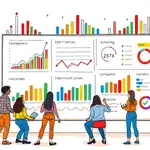
In recent months, automated trading has crossed thresholds that once seemed unimaginable. The fusion of advanced algorithms, high-speed networks, and cutting-edge analytics has propelled trading volumes to all-time highs. For traders, institutions, and market observers, these developments signal a profound shift in how financial instruments are bought, sold, and managed. From bond platforms to credit portfolios, algorithmic and AI-driven systems are rewriting the rules of engagement in global markets.
March 2025 emerged as a watershed moment when Tradeweb reported a record total trading volume of $59.6 trillion, equating to an average daily volume of $2.71 trillion. This performance represents a remarkable 49.9% year-over-year increase, underscoring the accelerating reliance on automated systems. Such volume spikes highlight the growing confidence of institutional and retail participants in the stability and efficiency of programmatic execution strategies.
Extending beyond a single snapshot, Q1 2025 saw trade volume surge to $164.5 trillion in trade volume with an ADV of $2.55 trillion, marking an impressive 33.7% year-over-year growth. Notably, platforms like MarketAxess recorded an 18.6% year-to-date market share in U.S. credit portfolio trading—up from 14.1% one year prior—indicating industry-wide momentum rather than isolated gains on a single venue.
The algorithmic trading landscape has expanded into a multibillion-dollar powerhouse. In 2024, the global algorithmic trading market valued at $19.95 billion demonstrated its maturity, and analysts forecast it projected to reach $38.4 billion by 2029 at a robust CAGR of 14.9%. This trajectory underscores the deepening integration of automated strategies across equities, derivatives, foreign exchange, and fixed income.
Concurrently, the AI trading platform sector is following an even steeper ascent. Valued at AI trading platform market valued at $13.52 billion in 2025, it is expected to skyrocket to $69.95 billion by 2034 at an approximate 20% CAGR. In the U.S. specifically, projections estimate a $20.33 billion market by 2034, fueled by rapid fintech proliferation and institutional adoption of machine learning and predictive analytics.
At the heart of this seismic growth lies the expansive influence of artificial intelligence and machine learning. Today, AI drives 89% of global trading, employing deep learning, natural language processing, and quantum computing experiments to automate order execution and strategy optimization. These systems sift through vast datasets unconstrained by human biases and speed limitations.
Simultaneously, the rise of big data and real-time analytics has transformed market visibility. By harnessing live feeds, enables real-time analysis and pattern recognition, traders gain actionable insights into emerging trends, liquidity pockets, and price anomalies. High-frequency trading engines and distributed ledger platforms further solidify the infrastructure that underpins instantaneous decision-making across asset classes.
As automated and AI-driven trading becomes ubiquitous, participants are refining tactics to maintain an edge:
These strategic shifts highlight the industry’s commitment to balancing agility with stability, ensuring that automated processes deliver reliable performance even under extreme market stress.
Several factors continue to propel the automated trading wave:
However, this evolution is not without obstacles. Regulatory landscapes are continually adapting, requiring firms to implement rigorous compliance frameworks. Data quality issues, infrastructure resilience, and the interpretability of complex AI models pose additional hurdles. Balancing innovation with stringent oversight remains a central challenge for market participants worldwide.
The rapid expansion of automated trading raises important questions about market fairness, transparency, and systemic risk. Regulators across North America, Europe, and Asia are intensifying their scrutiny, seeking to ensure that algorithm-driven activities do not amplify market shocks or disadvantage smaller investors.
Debates around ethical AI use highlight the need for clear guidelines. Firms must demonstrate that their models operate without bias and that automated decisions can be explained. As regulatory standards evolve, organizations that adopt proactive governance practices will likely gain a competitive and reputational advantage.
Looking ahead, the industry is poised for continued transformation. Sentiment analysis tools that scan social media, news, and alternative data sources are gaining traction, enabling traders to anticipate market moves with unprecedented foresight. Autonomous portfolio management platforms will offer holistic risk and performance optimization, while sustainability-focused algorithms may steer capital toward ESG-aligned assets.
Competition between incumbents and nimble startups will sharpen, driving further breakthroughs in latency reduction, model interpretability, and decentralized trading architectures. The integration of quantum computing experiments and decentralized AI frameworks could unlock entirely new paradigms in speed and complexity management.
In this era of boundless data and intelligent automation, market participants have a unique opportunity to harness cutting-edge technologies to enhance decision-making, manage risk more effectively, and deliver value to clients on a global scale. By embracing innovation, maintaining rigorous governance, and fostering collaborative ecosystems, traders and institutions can navigate the complexities of modern markets and achieve sustained success.
References













